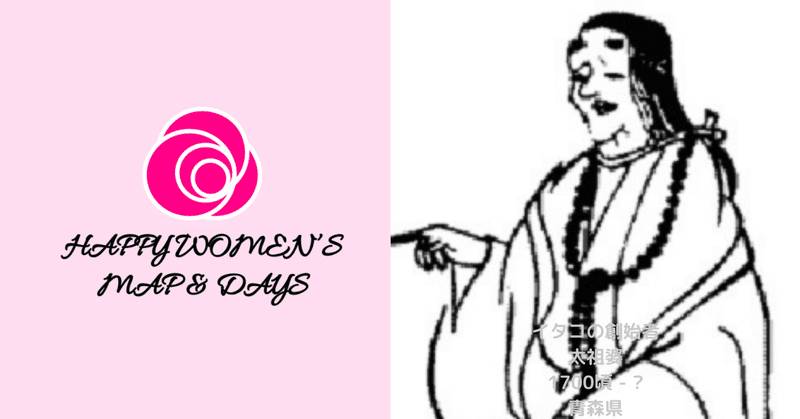
Happy Women's Map 青森県 視覚障害の女性の生業としてイタコを組織化・確立 太祖婆

太祖婆
Ms. Taiso-Ba
1700頃 - ?
青森県八戸市 生誕
Hachinohe-city, Aomori-ken
太祖婆は目の見えない女性の仕事としてのイタコの創始者です。江戸時代中期に青森県八戸市周辺で盲目の巫女として活躍。熊野巫女・比丘尼に学びながら、山伏惣禄・鳥林坊とその妻・高舘婆に祈祷また口寄せなど巫技を継承、盲目の女性をイタコとして組織化させました。
Taiso-ba is the founder of Itako as a profession for visually impaired women. She was active as a blind priestess in the vicinity of Hachinohe City, Aomori Prefecture, during the mid-Edo period. While learning from Kumano shrine maidens and nuns, she inherited the techniques of divination and spirit possession from Yamabushi ascetic leader Tōryōbō and his wife, Takadachi-ba. She organized visually impaired women into Itako, following their traditions.
*******
古代のシャーマンを起源とする巫女は、男性の神職による神社の組織化に比例して、社会的地位は段々と低下。神がその時々に巫女に憑って託宣をして祭らせたものが、男子の神職によって日時と場所を一定させた儀式として行われるようになり、巫女の本来の職務は失われ軽視され経済的に圧迫され、多くの巫女は神社を離れて古き伝えの呪術を以て世に処すようになります。民間の巫女には特に盲目の女性が重用され、太祖婆も村から村へまわって活躍します。一方、平安期に朝野を通じて熾烈なる信仰を集めていた熊野信仰は鎌倉期に衰え始め、社僧神人等の生活を維持するために修験者は護摩ノ灰を頒布して諸国を勧進、巫女達は口寄せの呪術師または地獄極楽の絵解き比丘尼として日本国中に向って漂泊の旅に出るようになります。巫女又は比丘尼は売色比丘尼と化し多大な収益を得るようになるも風紀を乱していました。太祖婆は、オシラ神はじめ熊野巫技に学びつつも、性的職業婦と化した巫女の末路を憂えます。一方、巫女から祈祷と呪術を取り入れた男性修験者は、道教・仏教を交えて拡張、多くは巫女を妻として民間信仰を味方につけて圧倒的な支持を得ていました。太祖婆は、山伏をまとめる支配頭で合った鳥林坊とその妻・高舘婆にこれまで培った巫技を継承、視覚障害の女性の生業としてイタコを組織化・確立させます。師匠のイタコについて修行し、経文や巫業の作法を学び、厳しい入巫式を経て一人立ちします。以降、青森南部のイタコは民間の巫女ならびに地域の人々のカウンセラーとして大切に継承されていきます。
In ancient times, shrine maidens, with origins rooted in ancient shamans, gradually saw their social status decline in proportion to the organization of shrines by male priests. What were once rituals where gods possessed the shrine maidens, providing oracles during ceremonies, became standardized rituals with specific dates and locations, overseen by male priests. The original duties of shrine maidens were lost and devalued, leading to economic hardship. Many shrine maidens left the shrines to practice traditional rituals independently. Blind women were particularly valued as shrine maidens in the private sector, and Tai Sohba also traveled from village to village, actively performing her role. Meanwhile, during the Heian period, Kumano faith, which had gathered fervent followers throughout the imperial court and society, began to wane in the Kamakura period. In order to sustain the lives of priests and shrine attendants, ascetic practitioners distributed Goma no Hai (sacred ashes) and embarked on pilgrimages to various regions. Shrine maidens began to roam the country, practicing divination and exorcism as itinerant nuns or practitioners of hell and paradise art (Jigoku Gokuraku no Ekaki Bikuni). Shrine maidens or nuns turned into courtesans, generating substantial income but also causing a disruption of public morals. Tai Sohba, while learning from the Kumano shrine techniques, grew concerned about the fate of shrine maidens who had turned to sexual professions. On the other hand, male ascetic practitioners who incorporated prayers and exorcism learned from shrine maidens expanded their influence through a blend of Taoism and Buddhism. Many of them married shrine maidens and gained overwhelming support from the local faith. Tai Sohba, as the leader of the mountain ascetics (Yamabushi), worked with Tōryōbō and his wife, Takadachi Ba, who she met. She passed on the accumulated shrine techniques, organizing and establishing Itako as a livelihood for visually impaired women. She trained under her mentor, learning scriptures and the rituals of shrine work, and after completing a rigorous initiation, became an independent practitioner. Subsequently, in southern Aomori, Itako have been treasured and passed down as counselors to both local shrine maidens and the community at large.
-青森県立郷土館 Aomori Prefectural Museum

Share Your Love and Happy Women's Story!
あなたを元気にする女性の逸話をお寄せください!
Share your story of a woman that inspires you!
この記事が気に入ったらサポートをしてみませんか?
